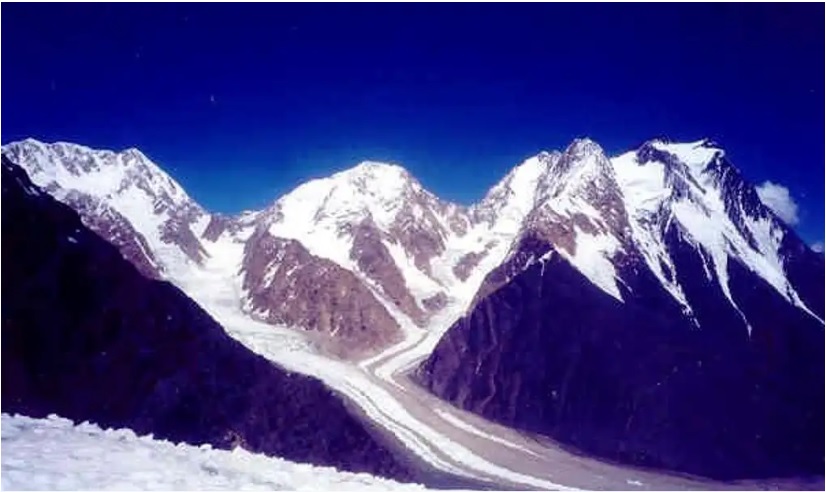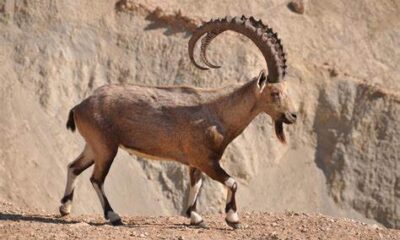Article
Tirich Mir Glacier: A Jewel of the Hindu Kush
Published
8 months agoon
By
EDITOR
Nestled in the northern reaches of Pakistan, the Tirich Mir Glacier is one of the most significant and majestic glaciers in the Hindu Kush mountain range. It lies beneath the towering peak of Tirich Mir, the highest mountain in the Hindu Kush, which rises to an elevation of 7,708 meters (25,289 feet). This glacier is not only a critical source of water for the region but also a site of immense natural beauty, attracting adventurers and mountaineers from around the world.
Geographical Location
- Region: The glacier is located in the Chitral District of Khyber Pakhtunkhwa, Pakistan.
- Coordinates: The approximate coordinates of Tirich Mir are 36.2536° N latitude and 71.8316° E longitude.
- Mountain Range: It lies within the Hindu Kush mountain range, a major range that extends into Afghanistan and northern Pakistan.
- Accessibility: The glacier is accessible through the Tirich Valley, which is a part of the Mastuj River basin.
Physical Characteristics
- Type: Tirich Mir Glacier is a valley glacier, flowing down from the slopes of the Tirich Mir peak.
- Length and Volume: The glacier spans several kilometers in length, though exact measurements fluctuate due to seasonal changes and long-term climatic effects. Its volume is significant, contributing to the hydrology of the region.
- Surface Features: The glacier is characterized by steep inclines, crevasses, seracs, and icefalls. Its surface is a mixture of ice and debris, with areas of exposed bedrock near its terminus.
- Flow: The glacier flows southwards from Tirich Mir, descending through the valley and feeding into the Tirich River.
Climatic Importance
The Tirich Mir Glacier is a crucial indicator of climate change in the region. Like many glaciers worldwide, it has been subject to the effects of global warming. Studies have shown that glaciers in the Hindu Kush-Himalayan region are retreating, and the Tirich Mir Glacier is no exception. This retreat has significant implications for the local water supply, agriculture, and the overall ecosystem.
The glacier’s seasonal meltwater is essential for maintaining river flow, especially during the summer. However, as the glacier retreats, there is a risk of reduced water availability in the future, which could have profound impacts on the communities that depend on it. Additionally, the retreat of the glacier could lead to the formation of glacial lakes, which pose a risk of outburst floods, potentially causing significant damage to downstream areas.
Mountaineering and Exploration
Tirich Mir, the peak above the glacier, has long been a magnet for mountaineers. The first successful ascent of Tirich Mir was made in 1950 by a Norwegian expedition, led by Arne Næss. Since then, the mountain and its surrounding glaciers have been a destination for climbers and adventurers from around the world.
The Tirich Mir Glacier is often part of the trekking and climbing routes taken by expeditions aiming to summit Tirich Mir or explore the surrounding peaks. The trek to the glacier itself is challenging, involving steep climbs, navigating crevasses, and enduring harsh weather conditions. However, the breathtaking views of the glacier, the surrounding mountains, and the valley below make the journey worthwhile.
Ecological Significance
The Tirich Mir Glacier is part of a larger ecological system that supports a diverse range of flora and fauna. The high-altitude environment of the glacier is home to various species of plants adapted to the harsh conditions, including alpine grasses, mosses, and lichens. These plants provide habitat and food for animals such as ibex, snow leopards, and various bird species.
The glacier and its meltwater also support the agriculture in the Tirich Valley, which is a vital source of livelihood for the local population. The cold, nutrient-rich waters from the glacier are used for irrigating crops such as wheat, barley, and vegetables, as well as for sustaining orchards of apples, apricots, and walnuts.
Cultural and Historical Context
The Tirich Mir Glacier and its surrounding areas hold significant cultural and historical importance for the people of Chitral. The local communities have a deep connection with the land, and the glacier is often seen as a symbol of the natural beauty and resilience of the region. The name “Tirich Mir” itself is steeped in local legend, with some interpretations suggesting it means “King of Darkness,” possibly referring to the shadow the peak casts over the valley.
The glacier and the mountain have also been the subject of local folklore and stories passed down through generations. These tales often speak of the challenges of living in such a remote and rugged environment, as well as the respect and reverence the people have for the natural world.
Challenges and Conservation Efforts
The Tirich Mir Glacier, like many others in the region, faces several challenges. The most pressing of these is the impact of climate change, which is causing the glacier to retreat at an alarming rate. This retreat threatens the water supply for local communities and could lead to increased risks of natural disasters such as glacial lake outburst floods (GLOFs).
Conservation efforts are needed to protect the Tirich Mir Glacier and the broader ecosystem it supports. This includes monitoring the glacier’s health, studying the impacts of climate change, and implementing sustainable water management practices. There is also a need to raise awareness about the importance of glaciers and the threats they face, both locally and globally.
Conclusion
The Tirich Mir Glacier is not just a mass of ice; it is a vital component of the natural, cultural, and economic landscape of Chitral and the Hindu Kush. Its towering presence beneath the highest peak in the region makes it a symbol of both the beauty and fragility of nature. As the world grapples with the challenges of climate change, the fate of the Tirich Mir Glacier serves as a reminder of the urgent need to protect our planet’s most precious resources. For the people of Chitral, and indeed for the entire region, the glacier is a lifeline that must be preserved for future generations.
You may like
-


The Chiltan Ibex: A Rare Treasure of Balochistan
-


MANGO HEALTH BENEFITS NUTRITION
-


“Rising above the rugged terrain of Balochistan, Koh-i-Chiltan stands as a symbol of mystery and resilience.”
-


Aik Qaum, Aik Sath | Pakistan Zindabad | Pakistan Day Song | 23rd March 2024 | AIKQAUM.COM
-


Nation celebrates Pakistan Day today with traditional zeal
-


Pakistan Day: A Reminiscence of the Heroic Struggle of Muslims of the Subcontinent
Article
The Chiltan Ibex: A Rare Treasure of Balochistan
Published
1 month agoon
April 16, 2025By
EDITOR
The Chiltan ibex (Capra aegagrus chiltanensis), a subspecies of the wild goat, is one of the most unique and endangered animals native to Pakistan. Found exclusively in the rocky highlands of the Chiltan range within the Hazarganji-Chiltan National Park in Balochistan, this elusive animal represents the region’s rich biodiversity and ecological heritage.
Physical Characteristics
The Chiltan ibex is a strikingly beautiful species, with a robust, muscular build perfectly suited for navigating steep and rocky terrains. Males are particularly distinctive, boasting impressive curved horns that can grow up to 30 inches (76 cm) in length. Their coat is light brown, with a darker stripe running along their back and legs, providing excellent camouflage in their arid mountainous habitat.
Females are smaller in size with shorter, more slender horns, and their coloration is less pronounced, blending seamlessly into their surroundings. This camouflage helps protect them and their offspring from predators such as wolves and large birds of prey.
Habitat and Range
The Chiltan ibex inhabits the rugged, semi-arid regions of the Chiltan range, located within the Hazarganji-Chiltan National Park, southwest of Quetta. These high-altitude areas, ranging from 1,500 to 3,200 meters above sea level, are characterized by rocky cliffs, sparse vegetation, and extreme weather conditions.
The ibex is well-adapted to this challenging environment, where it feeds on grasses, shrubs, and the leaves of juniper trees. Its ability to climb steep slopes and jump across narrow ledges gives it a unique advantage in escaping predators and surviving in such inhospitable terrain.
Behavior and Social Structure
Chiltan ibexes are diurnal, meaning they are active during the day. They are typically found in small groups, with herds consisting of females and their young. Males are more solitary, joining herds only during the breeding season, which occurs in the late autumn and winter months.
During this time, males engage in dramatic displays of strength to compete for mating rights, including horn clashing and dominance rituals. After a gestation period of around six months, females give birth to one or two kids in spring, when food availability is higher.
Conservation Status
The Chiltan ibex is classified as endangered due to its restricted range, habitat loss, and poaching. Habitat degradation caused by overgrazing, deforestation, and human encroachment poses significant threats to its survival.
Historically, the ibex faced heavy hunting pressure for its horns, considered a symbol of prestige, and for its meat. Although hunting is now banned in the national park, illegal poaching remains a concern.
Conservation Efforts
To protect the Chiltan ibex and its fragile ecosystem, the Hazarganji-Chiltan National Park was established in 1980. Spanning over 32,500 acres, the park provides a safe haven for the ibex and other wildlife, such as wolves, foxes, and birds of prey.
Conservation efforts include:
- Anti-Poaching Measures: Increased patrolling and strict enforcement of hunting bans have helped reduce poaching incidents.
- Habitat Restoration: Programs to control overgrazing and reforest juniper woodlands are underway to restore the ibex’s natural habitat.
- Public Awareness Campaigns: Local communities are being educated about the importance of biodiversity and the role of the Chiltan ibex in maintaining ecological balance.
- Eco-Tourism Initiatives: Promoting responsible tourism generates revenue for conservation projects and raises awareness about the ibex’s plight.
Ecological Importance
The Chiltan ibex plays a vital role in its ecosystem as both a grazer and prey species. By feeding on shrubs and grasses, it helps maintain vegetation balance, preventing overgrowth and contributing to soil health. At the same time, it serves as a food source for predators, sustaining the natural food chain.
Protecting the ibex is not just about saving a single species—it’s about preserving an entire ecosystem that supports numerous forms of life, from tiny insects to apex predators.
Cultural Significance
For the people of Balochistan, the Chiltan ibex is more than just a wild animal; it is a symbol of the region’s natural beauty and resilience. Local folklore often intertwines with the ibex, celebrating its agility and strength. The species also draws international attention, making it a flagship for wildlife conservation in Pakistan.
The Future of the Chiltan Ibex
While conservation efforts have shown promise, the Chiltan ibex remains vulnerable. Protecting this rare species requires continued collaboration between government agencies, conservation organizations, and local communities.
By safeguarding the Chiltan ibex, we not only preserve a unique animal but also protect the fragile ecosystem of Balochistan, ensuring that future generations can marvel at the beauty and resilience of this incredible species.
The Chiltan ibex is a testament to nature’s ability to adapt and survive in the harshest of environments. As efforts to protect it continue, this majestic animal stands as a beacon of hope for wildlife conservation in Pakistan.
Article
“Rising above the rugged terrain of Balochistan, Koh-i-Chiltan stands as a symbol of mystery and resilience.”
Published
1 month agoon
April 16, 2025By
EDITOR
Koh-i-Chiltan, located in the rugged terrain of Balochistan, Pakistan, is not just a striking natural feature but also a site steeped in folklore, mysticism, and ecological significance. Rising to a height of approximately 3,194 meters (10,479 feet), it is the third-highest peak in the Chiltan range, forming part of the Sulaiman Mountain system. The mountain holds a commanding presence in the landscape and attracts mountaineers, nature lovers, and those intrigued by its legends.
Geography and Location
Koh-i-Chiltan is situated within the Hazarganji-Chiltan National Park, about 20 kilometers southwest of Quetta, the provincial capital of Balochistan. The name “Koh-i-Chiltan” translates to “The Mountain of Forty Spirits,” derived from local folklore that has become intertwined with its identity.
The surrounding park, spread across 32,500 acres, is a semi-arid region characterized by rugged cliffs, deep ravines, and sparse vegetation. The area is home to a diverse ecosystem, ranging from juniper forests to an array of fauna, including the Chiltan markhor, a rare wild goat species named after the mountain.
The Legend of the Forty Spirits
The legend of Koh-i-Chiltan is one of the most captivating tales of the region. According to local folklore, the mountain is haunted by the spirits of forty abandoned children. The story goes that a couple, unable to have children, sought help from a mystic who blessed them with forty babies. Overwhelmed by the burden of raising so many children, the couple is said to have abandoned them on the mountain.
The children, according to the legend, were nurtured by the mountain itself and eventually transformed into spirits. Locals believe these spirits still guard the mountain, and stories abound of mysterious voices, sightings, and unexplainable phenomena experienced by those who venture into the area.
This haunting narrative has contributed to the mountain’s mystique, drawing spiritual seekers and adventurers alike to experience its enigmatic aura.
Ecological Importance
Koh-i-Chiltan is not just a place of legends but also a significant ecological zone. The mountain and its surrounding national park serve as a critical habitat for the endangered Chiltan markhor, which is endemic to the region. Efforts to conserve this species have made the mountain a focal point for environmentalists and wildlife researchers.
The park also hosts other wildlife, including wolves, hyenas, foxes, and various bird species, making it a biodiversity hotspot. The juniper forests in the region are among the oldest in the world, some dating back several thousand years, and play a vital role in maintaining the ecological balance of the arid environment.
Tourism and Adventure
Koh-i-Chiltan is a growing destination for eco-tourism and adventure enthusiasts. Trekkers and climbers are drawn to the mountain’s challenging trails, which offer panoramic views of the surrounding landscapes. The Hazarganji-Chiltan National Park provides additional opportunities for hiking, wildlife observation, and photography.
Visitors to the mountain often report an eerie silence and a sense of being watched, experiences that only add to the allure of exploring Koh-i-Chiltan. Those interested in local culture and history will find the legends and traditions associated with the mountain as compelling as its natural beauty.
Cultural Significance
For the people of Balochistan, Koh-i-Chiltan holds cultural and spiritual importance. The mountain is a symbol of resilience and mystery, reflecting the character of the region itself. Local festivals and storytelling often feature the legend of the forty spirits, preserving the mountain’s legacy in the collective memory of the community.
Challenges and Conservation Efforts
Despite its significance, Koh-i-Chiltan faces challenges such as deforestation, overgrazing, and climate change. Conservation efforts, led by both government and non-governmental organizations, aim to protect the mountain’s delicate ecosystem. Initiatives include reforestation programs, wildlife monitoring, and community engagement to promote sustainable tourism.
Article
Aik Qaum: The Fusion of Integrity and Patriotism
Published
2 months agoon
March 19, 2025By
EDITOR
We keep Integrity closest to our Heart and Patriotism on top of our mind.
Integrity and patriotism are not separate entities; they are intertwined in the soul of Pakistan. The people understand that to be a patriot is to uphold the principles of integrity. Honesty and love for one’s country are two sides of the same coin. Together, these values form the essence of “Aik Qaum.”
The fusion of integrity and patriotism is evident in the everyday lives of Pakistanis. It’s in the farmer toiling the fields, the teacher educating the youth, and the soldier guarding the borders. It’s in the child who dreams of a better Pakistan and the elderly who have seen the nation grow. “Aik Qaum” is the realization that integrity and patriotism are the heart and mind of Pakistan, beating in unison to guide the nation forward.
As we celebrate the spirit of “Aik Qaum,” we honor the values that make Pakistan a unique and resilient nation. Integrity and patriotism serve as our guiding stars, leading us towards a brighter and more prosperous future. In the heart of every Pakistani and at the forefront of their minds, “Aik Qaum” stands as a testament to the strength of a united nation, bound by the principles of integrity and the unyielding love for their homeland.
In Pakistan, “Aik Qaum” is not just a motto; it’s a way of life that embodies the enduring spirit of a proud and united nation.

The Chiltan Ibex: A Rare Treasure of Balochistan

MANGO HEALTH BENEFITS NUTRITION








